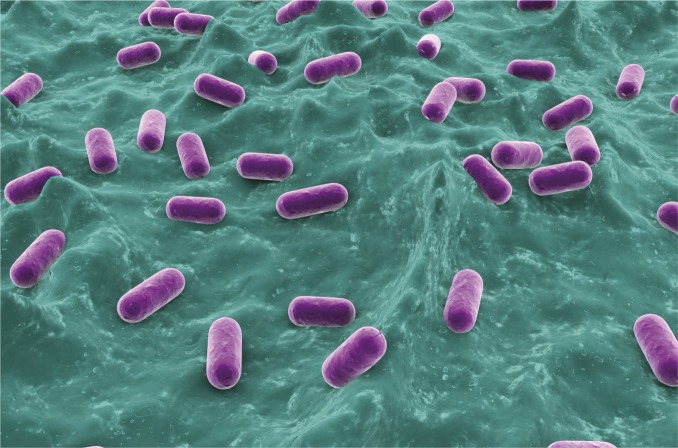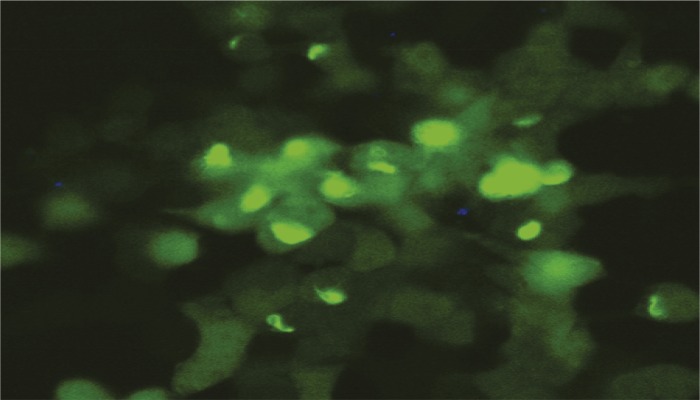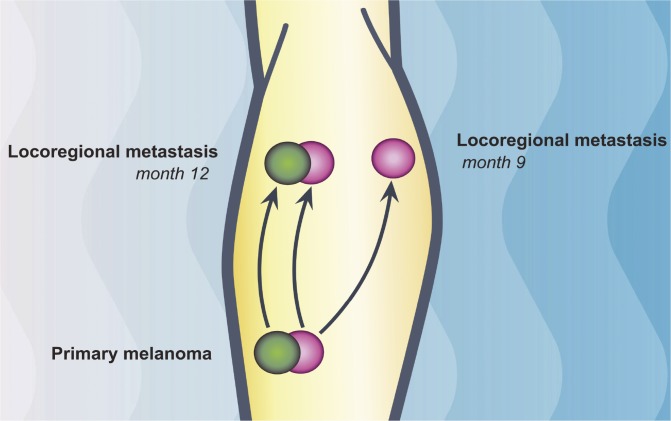Microbiomes and risk of preterm birth
Microbiomes might indicate risk of preterm birth. Image courtesy of iStockphoto/Eraxion.
Preterm birth, which occurs before 37 weeks of gestation, afflicts 11% of pregnant women worldwide and has been inconclusively tied to the relative abundances of microbes in and on the human body. In a longitudinal case-control study of microbiomes and preterm birth, Daniel DiGiulio et al. (pp. 11060–11065) sampled microbial communities every week of gestation and after delivery in the vagina, stool, saliva, and tooth/gum of 49 pregnant women 18 years of age or older, of whom 15 delivered preterm infants. Microbiome composition and diversity largely remained stable throughout pregnancy. Vaginal microbiome analysis yielded five major types of communities, four of which were dominated by a different Lactobacillus species. The fifth type, poor in Lactobacillus but rich in diverse species, was associated with preterm delivery in a dose-dependent manner. In some women with Lactobacillus-poor vaginal microbiomes, an abundance of Gardnerella and Ureaplasma was tied to preterm birth. Most women displayed an abrupt and persistent change in microbiome composition after delivery, whether vaginal or cesarean, toward a diverse microbiome marked by low levels of Lactobacillus as well as the appearance of anaerobic bacteria such as Prevotella and Peptoniphilus. According to the authors, microbiomes in early gestational stages might offer clues to the risk of preterm birth and influence maternal health after delivery. — P.N.
Gene sets linked to memory processes
Memories of personal experiences, known as episodic memories, rely on distinct cognitive processes. Although past studies have identified genetic variations associated with general memory performance, relatively little is known about the genetic underpinnings of specific memory-related mental processes, such as learning and memory maintenance. Gediminas Luksys et al. (pp. E4939–E4948) performed a genome-wide association study (GWAS) of 1,765 healthy young adults to identify sets of biologically related genes involved in different components of episodic memory. In a verbal memory task, participants were asked to recall neutral, positive, and negative words immediately after the initial presentation and 5 minutes later. Computational modeling of behavioral data revealed distinct memory-related processes, which were associated with four separate gene sets identified from GWAS data. For example, the learning rate was associated with amine compound solute carrier transporters, the modulation of memory strength by negative emotions was associated with collagen formation, and repetition-based memory improvement was associated with L1 cell adhesion module interactions. Some of these genes were previously implicated in neurological and psychiatric disorders, neuronal development, learning, and memory. The findings suggest that distinct genetic profiles might underlie specific mental processes of human episodic memory. According to the authors, analysis of memory-related genetic pathways could lead to the development of therapies for neuropsychiatric disorders. — J.W.
El Niño and salmon survival
Coho salmon released from hatchery. Image courtesy of the Southwest Fisheries Science Center, NOAA Fisheries Service.
Changes in the survival of salmon populations in the northeast Pacific have been historically explained by the Pacific Decadal Oscillation (PDO), a recurring pattern of changes in ocean conditions driven by El Niño-associated eastern Pacific warming. Recently, another El Niño-associated pattern, the North Pacific Gyre Oscillation (NPGO), has exerted increasing influence on ocean conditions compared with the PDO, but the impact of the NPGO on salmon survival rates is not well understood. D. Patrick Kilduff et al. (pp. 10962–10966) tracked the survival of Chinook and coho salmon from hatcheries in western North America between 1980 and 2006. The variation in both species’ survival rates correlated more closely with the NPGO than with the PDO. Furthermore, the similarity between the survival rates of the two species increased from the early 1990s to the present. Biodiversity tends to stabilize ecosystem services in the same way that diversity of stock holdings stabilizes return on investment. Therefore, increased similarity in survival rates among different salmon species suggests reduced stability of overall salmon survival. The variability in salmon survival due to the NPGO should be taken into account in salmon management strategies, according to the authors. — B.D.
Prions in Parkinson’s and other neurodegenerative diseases
MSA prion-infected cells where α-synuclein coupled with yellow fluorescent protein aggregates appear as bright green spots.
Proteins that adopt self-propagating alternative shapes, prions are increasingly implicated in neurodegenerative disorders. Previous studies have linked tau prions, to progressive supranuclear palsy (PSP) and α-synuclein prions to multiple system atrophy (MSA). Amanda Woerman et al. (pp. E4949–E4958) purified prions from the brains of deceased patients with PSP or MSA, and applied these prions to cell culture models expressing fusion proteins that selectively aggregate upon exposure to tau or α-synuclein prions, respectively. The fusion proteins were generated by coupling yellow fluorescent protein to either a tau fragment or α-synuclein, both carrying point mutations that cause familial forms of PSP or Parkinson’s disease (PD), respectively. Whereas MSA samples were previously reported to transmit neurological disease to transgenic mice, inoculation with PD samples failed to induce prion disease, suggesting that distinct α-synuclein prions cause each disorder. The authors’ cell assay allowed examination of α-synuclein prions in the human brain samples in 4 days, in contrast to previous mouse transmission studies that required 120 days. Brain homogenates from two patients with PSP and six patients with MSA infected the cultured cells, whereas homogenates from three patients with PD did not. The findings suggest that MSA is caused by several different prion strains and that still other unidentified strains of α-synuclein prions are likely to cause PD, according to the authors. — A.G.
Tracing the lineage of metastasized melanomas
Multiple genetically distinct cells (pink, green) in a primary melanoma can cofound a single metastasis. Image courtesy of Sarah Pyle (graphic designer).
Once melanoma cells migrate to other tissues, successful treatment becomes difficult. Determining whether metastases are seeded in a sequential fashion, colonizing one site after another, or in parallel from the primary tumor could help inform treatment. Zachary Sanborn et al. (pp. 10995–11000) performed phylogenetic analysis of primary human melanomas and multiple metastasized tumors to trace the lineage of the cancerous cells. The authors performed whole-exome sequencing on primary tumors and tissue from metastasized sites in eight patients to document mutations in the sequence of protein-coding genes. The primary melanomas contained between 96 and 4,900 somatic single nucleotide variants (SSNVs). Comparing the pattern of SSNVs in primary tumors with metastases, the authors found in two patients that multiple cells from the primary melanoma seeded single metastases, potentially enhancing the genetic heterogeneity of the metastases. In five patients, metastases disseminated in parallel from a common subpopulation of cells in the primary tumor to multiple sites, posing a potential challenge to treatment guidelines based solely on sequential spread. According to the authors, a common ancestral population also suggests that the ability of cancer cells to metastasize may have arisen later during the primary tumor’s evolution and could narrow the search for genes involved in metastasis. — T.H.D.
Generating retinal pigment epithelium
No approved treatments exist for the dry, or atrophic, form of age-related macular degeneration (AMD), a leading cause of blindness among the elderly. Given that damaged retinal pigment epithelium (RPE) is important in AMD pathogenesis, one promising treatment approach is to generate RPE cells from a patient’s induced pluripotent stem cells (PSCs) and transplant the resulting cells into the diseased eye. Julien Maruotti et al. (pp. 10950–10955) developed a method for generating RPE from human PSCs. Using quantitative real-time PCR, the authors screened a library of approximately 300 small molecules for the ability to stimulate RPE differentiation. One compound, the fungal metabolite chetomin, was found to induce differentiation in four independent human PSC lines. Cell survival was enhanced by cotreatment with nicotinamide, and differentiation was promoted by growth in a defined RPE growth medium. In this medium, the authors obtained a monolayer of polygonal pigmented cells that expressed key RPE markers and displayed characteristics of native RPE, including cellular polarity. The cells phagocytosed photoreceptor outer segments, a key RPE function, and upon transplantation into mouse eyes, integrated within the RPE layer. The protocol represents a high-efficiency method for RPE generation that may aid the development of RPE cell-based strategies for the treatment of AMD, according to the authors. — C.B.






